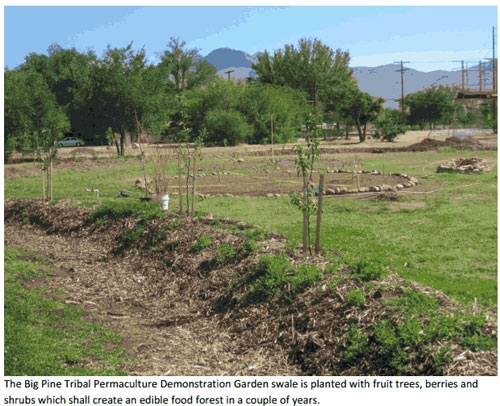Do you recycle? Compost? Plant a vegetable garden? Have fruit trees? Raise chickens? If so, you are already practicing permaculture.
A while back, a fellow Master Gardener shared an article about permaculture, which enticed me to research and explore local permaculture practices. The term ‘permaculture' was coined in the mid-1970's by two Australians, Bill Mollison and David Holmgren, to describe a philosophical approach to living and gardening: permanent culture and permanent agriculture. What sparked this line of thought was a reaction to the petroleum shortages of the era, food shortages, and the desire for self-reliance. Combining philosophy and practical application, permaculture encompasses anything from recycling, reusing and regeneration, to simply observing.
Most formal definitions explain that permaculture is an ecological design system for sustainability in all aspects of human endeavor. Inspired by nature, it teaches how to design natural homes and abundant food production systems, regenerate degraded landscapes and ecosystems, develop ethical economies and communities, and much more. As an ecological design system, permaculture focuses on the interconnections between things more than individual parts.
Permaculture philosophy proceeds from three ethical principles: Care for Earth, Care for People, Care for Community. Design for anything must be held up to these ethics– care of the earth is the prime goal, the root of sustainability. Care of people is rooted in respect for self,family, and culture. Reinvesting surplus creates equality, as everyone gets their fair share– no one takes more than they need.
By adopting these ethics and applying these principles in daily life, a transition from dependent consumers to responsible producers is possible, building skills and resilience to face an uncertain future with less available energy. Permaculture envisions a world of abundance for all beings and aims to supply natural human rights: clean water, clean air, clean food, access to land, safe affordable housing, ethical meaningful work, community, and spiritual freedom.
This philosophy goes beyond Backyard Gardening – it is a very big idea. Yet, the pervasive thought is that agriculture, big or small, is a good place to begin. Permaculturists aim to design agriculturally productive ecosystems that have the stability, diversity and resilience of natural ecosystems. Creating a permaculture environment is a gradual process that involves discerning optimal methods for integrating water catchment, human shelter and energy systems with tree crops, edible and useful perennials, self-seeding annuals, domestic and wild animals and aquaculture. Methods include the use of excess or waste products as nutrients to benefit other elements in the system. Plantings can be arranged in patterns to catch water, filter toxins, absorb nutrients and sunlight and block the wind. Particular associations of trees, perennial vines, shrubs and groundcovers known to nourish and protect one another are clustered together. Ponds and other elements are incorporated in patterns to maximize their edges to take advantage of the increased biological activity at the intersection of two ecosystems.
Since 1981, the permaculture community has offered two-week intensive design courses around the world. These workshops, courses and seminars help to form a loose global network. I recently had the pleasure of participating in a week-long permaculture workshop hosted by the Big Pine Paiute-Shoshone Tribe. This workshop came about as an extension of the idea that tribal sovereignty must include food sovereignty.

In addition to the Big Pine Tribe, there are several entities in the Owens Valley quietly working to incorporate these principles into their work. The Owens Valley Growers Cooperative – along with the Eastern Sierra Certified Farmers Market – espouses these principles in its quest to provide wholesome food for all. The Metabolic Studio (derived from “metabolism”, the process that maintains life) has a goal of transforming resources into energy, actions and objects that nurture life by working to sustain the continuous cycles of creation and destruction of energy and matter. To that end, the Metabolic Studio Soil Exchange (headed by Julie Fought, a Master Gardener) transforms manure, water and waste carbons (leaves,paper, cardboard) into compost. The project aims to capacitate the region toward food sovereignty by offering local growers improved soil. Compost users are encouraged to see their role in the community as one of vital participation. The exchange aims to create community by collaborating with local pack stations, local businesses, neighbors and the larger community. It supports local food production and addresses the issues of healthy food choices in a region that is isolated and economically challenged.
Rooted in and inspired by long-time practices of people and cultures all over the world, permaculture can become a vital tool for food growers and gardeners alike. The facilitator at the Big Pine workshop explained that the first step is always observation– a commonsense, but often overlooked, approach. She encouraged us to: consider the natural inclination of our site along with the needs of its inhabitants; observe light,wind, and water through the seasons to discern microclimates before planting, and; plan plots with a nod to zones. Considerations of which plants will be visited the most and which will require the most tending can help us identify which should be planted closest to the house, thus receiving the attention they need to thrive. Plants placed farthest from the house should be those that require less attention. Beyond that is the wild, undisturbed haven for nature and wild life.
After observation and planning, composting and sheet mulching can help get things growing without turning the soil. Companion planting, natives, and edible landscaping with hardy perennials are encouraged, as is the use of natural predators for pest control. Employing such sustainable practices is economical, beneficial to all living things and,at the end of the day, satisfying, as we observe the fruits of our labor and harvest our daily meals. Perhaps as we enjoy and share these gifts, we can contemplate the “big ideas”of permaculture.
Resources: